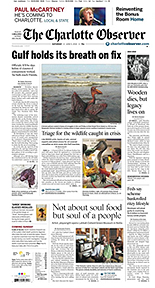"Going Local"

Charlotte Observer
At the same time, the Observer had been making its own changes. The advent of the Web had affected its operations profoundly. In 2009, the paper lost 21,000 daily and 18,400 Sunday readers (circulation declinesof 11 and 8 percent respectively). [1] Its weekday circulation dropped to just over 167,000, the lowest since 1986. In March 2009, Thames was forced to cut staff by 14.6 percent and reduce the payand in some cases the hoursof most remaining employees. [2]
As Thames and his executive team pondered how to strategically re-position their news franchise, they kept coming back to what they knew best: local news. Notes Thames: As we gradually came to terms with the advances of other media, we started looking more to local. The papers content decisions, and sources of coverage, came to reflect this conclusion. Content analysis of Section A of the Observer reveals shifting fault lines from 2000 to 2008. [3] From 20002008, staff-reported stories on local and regional topics grew as a relative percentage of overall section content. [4] The Observer also accentuated local content on the front page, with 57 percent of staff-generated Section A reports reaching the front in both 2005 and 2008, as opposed to 52 percent in 2000 and 32 percent in 1985. By contrast, total AP content dipped from 2000 to 2005 and steadied in 2008 primarily as a result of demand for Presidential election coverage. [5]
Even with this evolution, however, the AP maintained a prominent place in the Observer s pages. While Section A local content enjoyed relative growth, AP stories continued to account for the majority of material appearing in the section, augmented by supplemental wire services such as the New York Times News Service and McClatchy-Tribune Information Services. AP briefs (short news vignettes) rounded out the Observer s pages, especially as the financially-strapped paper shrank its news hole to save money in printing costs. We still have to be an aggregator of sorts because the bulk of our core readers are not as Internet savvy as you might think, says Observer National Editor Rich Mathieson . A lot of them do still rely on us to be the paper of record. [6]
McClatchy purchase. Meanwhile, an unexpected outside development reinforced the Observer s move toward a more local mission. In March 2006, McClatchy acquired Knight Ridder. [7] The merger provided the Charlotte Observer with additional influence throughout the Carolinas. [8] In South Carolina, McClatchy already owned three dailiesthe Beaufort Gazette , the Herald (Rock Hill), and the Island Packet (Bluffton). It added the Sun News (Myrtle Beach) and the State (Columbia), which was the largest daily in the state. Combined with its assets in Charlotte and Raleigh, McClatchy was now the dominant news provider in the Carolinas.
With Charlotte perched just 20 miles from the South Carolina border, news from its southern neighbor was relevant to many of the Observer s readers. Now it was accessible and plentiful. We suddenly had these other papers around us in the Carolinas that became our sister papers, Thames recalls.
Here we are with seven sister papers regionally. We were fascinated by that and said, If we work together, we can actually make our report richer because were going to accommodate each others special needs in the process.
CaroNews. Later in the summer of 2006, the seven North Carolina and South Carolina dailies settled on a news-sharing arrangement called CaroNews. The papers implemented technology that allowed the various staffs to coordinate their planning and coverage. [9] Our publishing system has allowed us to see what the other McClatchy papers are working on [in real time], says Mathieson.
CaroNews is an extension of the sharing that allows us to share budgets [the stories and projects developed on a particular day], see stories, and request stories from our sister papers. We share quite a bit with South Carolina. We actually share a copy desk and lots of resources with Rock Hill. We also get quite a few stories from Columbia and Myrtle Beach.
In 2008, the two star papers in the new cooperative took an even more dramatic step. For decades the Observer , a Knight Ridder property, and its Raleigh counterpart, the McClatchy-owned News & Observer , had competed fiercely. [10] As the two most-widely circulated dailies in the Tar Heel state, they vied for scoops on subjects ranging from state politics to basketball to news investigations.
But after two years under McClatchy ownership, Observer Editor Thames and his Raleigh counterpart, John Drescher, decided to see whether they could wring some efficiency out of combining several operations. They merged their capital bureaus and sports staffs and eventually did the same with the features staffs. [11] An editor from Charlotte oversaw sports, while editors from Raleigh supervised features and state politics. The two staffs co-produced and co-edited the sections. Once the initial awkwardness of partnering with longtime rivals subsided, Thames began to appreciate how the collaborative efforts had extended his papers news footprint.
Listen to Thames discuss the benefits of sharing news.
Questions did arise about reducing the number of distinct news voices covering state government at a time when many media companies had taken the economic decision to limit their presence in Raleigh. Rob Christensen, a 32-year statehouse reporter for the News & Observer , stresses that the more eyes and ears, the better it is for the citizenry and the harder it is to cover up a story. [12] Initial concern, however, defused as shared resources meant formerly over-committed journalists could specialize. According to then- Observer politics reporter Mark Johnson, weve done some very different things already. Now Im on an actual beat. Im more consistently focused on a limited area, the executive branch, so Im talking to the governors office a lot more. It allows me to report with more depth and detail. [13]
Sports editors divided basketball assignments among the merged staff. Reporters were encouraged to disclose to their counterparts special projects that they were working on. This limited redundant coverage and allowed the sister paper to fully incorporate and promote the work. Gary Schwab, who headed the new arrangement, applauded the new workflow efficiencies and expanded story reach that sharing created, although he conceded that telling each other what were working on was like the New York Yankees and Boston Red Sox exchanging strategies for an upcoming three-game series in the midst of a heated pennant race. [14]
Newfound benefits also extended to the editing process. National Editor Mathieson extolled the arrangement for enabling the paper to be more efficient in our production methods. It allows us to share copy editors and line editors and designers. For example, a story can be line edited in Raleigh, copy edited in Charlotte, and then run in both papers.

City of Charlotte
Charlotte Observer
Local net . As the Observer leveraged its corporate parent to enrich its state and regional coverage, it continued to solidify its focus on local news. This meant dedicated staff and space in the paper for local reporting, but also cultivating new sources of news that broadened and deepened its foothold within the greater Charlotte area. Early in 2009, Innovations Editor Steve Gunn began a search for new fishing holes for news. [15] Over the course of the year, his casting net reeled in an eclectic cluster of 12 local websites that he hoped would help the paper make sure everybody in Charlotte gets the best news and information possible when we cant afford to do it all.
Slated to start in early 2010 as the Charlotte News Network, the website consortia would not replace standard newsroom coverage, but would provide a valuable assist to constrained staff and newsroom resources. [16] It also would carry the Observer s brand into urban, suburban, and even rural outposts. Qcitymetro.com, for example, could contribute cultural stories from Charlottes African-American community. DavidsonNews.net would provide feet on the ground in Davidson, a southern suburb around Davidson College. Editor Thames expected upwards of 200 stories and photos from community contributors to appear in the Observer s pages in 2010.
The Observer envisioned a local advertising network built around the blogs that would allow sponsors to make targeted buys across selected sites, with the respective blog and the newspaper splitting the income. This is the digital version of journalism beginning to sprout across the landscape, remarks Thames.
Whats interesting is that were organizing it for our region, and the AP may be missing an opportunity. Now, it may be that this development is too small for them and isnt going to be their mission anymore. But if youre talking about supporting institutions that are covering news, it strikes me that we are making moves now to organize partners in a way that was once the beginnings of an AP.
[1] Mark Washburn, Newspaper circulation continues to drop, Charlotte Observer , April 27, 2010.
[2] Pressure on the Presses, Wall Street Journal .
[3] The Charlotte Observer had five daily sections: Section A, Local and State, Sports, Business, and Entertainment. Traditionally, Section A served as a gateway into the rest of the paper and was dominated by non-local news. In 1985, for instance, a coded sample revealed that more than 86 percent of total Section A content originated from non-local sources. Also: The author coded a sample of Section A stories in the Charlotte Observer from 1985 through 2008, organizing the study in five-year increments (1985, 1990, 1995, 2000, 2005, and 2008). 2008 was selected because it was the last full year of content available to research when the project was completed in fall 2009. Content analysis was then performed to determine trends in news sources and coverage.
[4] See: Appendix 1
[5] People couldnt get enough of that and were very engaged and letting us know that they wanted to read this, recalls Observer National Editor Rich Mathieson.
[6] Authors interview with Rich Mathieson in Charlotte, NC, on February 9, 2010. All further quotes from Mathieson, unless otherwise attributed, are from this interview.
[7] David Lieberman, McClatchy to buy Knight Ridder for $4.5 billion, USA Today , March 13, 2006. To complete the acquisition, McClatchy assumed $2 billion in Knight Ridder debt.
[8] See:Lieberman, supra note 44.
[9] McClatchys Carolina Papers to Connect via CCI Newsgate Data Center, CCI Europe, January 8, 2008.
[10] Knight Newspapers bought the Charlotte Observer in 1955. Knight then merged with Ridder Publications in 1974, becoming Knight Ridder.
[11] Fiona Morgan, The N&O cuts 70 jobs, consolidates coverage with Charlotte Observer , Independent Weekly , June 18, 2008.
[12] Authors telephone interview with Rob Christensen on November 12, 2008. All further quotes from Christensen, unless otherwise attributed, are from this interview.
[13] Authors telephone interview with Mark Johnson on November 14, 2008. All further quotes from Johnson, unless otherwise attributed, are from this interview.
[14] Gary Schwab, When Fierce Competitors Join the Same Team, Nieman Reports , Nieman Foundation for Journalism at Harvard University, Fall 2008.
[15] Authors telephone interview with Steve Gunn on January 4, 2011. All further quotes from Gunn, unless otherwise attributed, are from this interview.
[16] See: Pressure on the Presses, supra note 4.